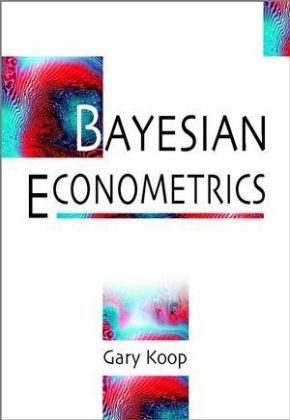Read more
Informationen zum Autor Gary Koop is Professor of Economics at the University of Glasgow. Klappentext Bayesian Econometrics introduces the reader to the use of Bayesian methods in the field of econometrics at the advanced undergraduate or graduate level. The book is self-contained and does not require previous training in econometrics. The focus is on models used by applied economists and the computational techniques necessary to implement Bayesian methods when doing empirical work. It includes numerous numerical examples and topics covered in the book include:* the regression model (and variants applicable for use with panel data* time series models* models for qualitative or censored data* nonparametric methods and Bayesian model averaging.A website containing computer programs and data sets to help the student develop the computational skills of modern Bayesian econometrics can be found at: www.wiley.co.uk/koopbayesian Zusammenfassung Researchers in many fields are increasingly finding the Bayesian approach to statistics to be an attractive one. This book introduces the reader to the use of Bayesian methods in the field of econometrics at the advanced undergraduate or graduate level. Inhaltsverzeichnis Preface xiii 1 An Overview of Bayesian Econometrics 1 1.1 Bayesian Theory 1 1.2 Bayesian Computation 6 1.3 Bayesian Computer Software 10 1.4 Summary 11 1.5 Exercises 11 2 The Normal Linear Regression Model with Natural Conjugate Prior and a Single Explanatory Variable 15 2.1 Introduction 15 2.2 The Likelihood Function 16 2.3 The Prior 18 2.4 The Posterior 19 2.5 Model Comparison 23 2.6 Prediction 26 2.7 Empirical Illustration 28 2.8 Summary 31 2.9 Exercises 31 3 The Normal Linear Regression Model with Natural Conjugate Prior and Many Explanatory Variables 33 3.1 Introduction 33 3.2 The Linear Regression Model in Matrix Notation 34 3.3 The Likelihood Function 35 3.4 The Prior 36 3.5 The Posterior 36 3.6 Model Comparison 38 3.7 Prediction 45 3.8 Computational Methods: Monte Carlo Integration 46 3.9 Empirical Illustration 47 3.10 Summary 54 3.11 Exercises 54 4 The Normal Linear Regression Model with Other Priors 59 4.1 Introduction 59 4.2 The Normal Linear Regression Model with Independent Normal-Gamma Prior 60 4.3 The Normal Linear Regression Model Subject to Inequality Constraints 77 4.4 Summary 85 4.5 Exercises 86 5 The Nonlinear Regression Model 89 5.1 Introduction 89 5.2 The Likelihood Function 91 5.3 The Prior 91 5.4 The Posterior 91 5.5 Bayesian Computation: The Metropolis-Hastings Algorithm 92 5.6 A Measure of Model Fit: The Posterior Predictive P-Value 100 5.7 Model Comparison: The Gelfand-Dey Method 104 5.8 Prediction 106 5.9 Empirical Illustration 107 5.10 Summary 112 5.11 Exercises 113 6 The Linear Regression Model with General Error Covariance Matrix 117 6.1 Introduction 117 6.2 The Model with General 118 6.3 Heteroskedasticity of Known Form 121 6.4 Heteroskedasticity of an Unknown Form: Student-t Errors 124 6.5 Autocorrelated Errors 130 6.6 The Seemingly Unrelated Regressions Model 137 6.7 Summary 143 6.8 Exercises 144 7 The Linear Regression Model with Panel Data 147 7.1 Introduction 147 7.2 The Pooled Model 148 7.3 Individual Effects Models 149 7.4 The Random Coefficients Model 155 7.5 Model Comparison: The Chib Method of Marginal Likelihood Calculation 157 7.6 Empirical Illustration 162 7.7 Efficiency Analysis and the Stochastic Frontier Model 168 7.8 Extensions 176 ...

